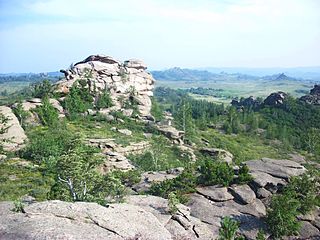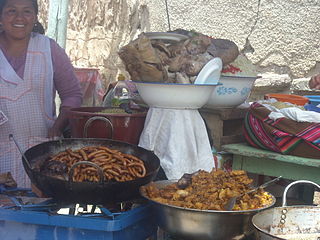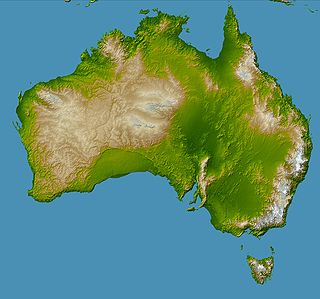
In geography, a plain, commonly known as flatland, is a flat expanse of land that generally does not change much in elevation, and is primarily treeless. Plains occur as lowlands along valleys or at the base of mountains, as coastal plains, and as plateaus or uplands. Plains are one of the major landforms on earth, being present on all continents and covering more than one-third of the world's land area. Plains in many areas are important for agriculture. There are various types of plains and biomes on them.

A tor, which is also known by geomorphologists as either a castle koppie or kopje, is a large, free-standing rock outcrop that rises abruptly from the surrounding smooth and gentle slopes of a rounded hill summit or ridge crest. In the South West of England, the term is commonly also used for the hills themselves – particularly the high points of Dartmoor in Devon and Bodmin Moor in Cornwall.

The Namib is a coastal desert in Southern Africa. According to the broadest definition, the Namib stretches for more than 2,000 kilometres (1,200 mi) along the Atlantic coasts of Angola, Namibia, and northwest South Africa, extending southward from the Carunjamba River in Angola, through Namibia and to the Olifants River in Western Cape, South Africa. The Namib's northernmost portion, which extends 450 kilometres (280 mi) from the Angola-Namibia border, is known as Moçâmedes Desert, while its southern portion approaches the neighboring Kalahari Desert. From the Atlantic coast eastward, the Namib gradually ascends in elevation, reaching up to 200 kilometres (120 mi) inland to the foot of the Great Escarpment. Annual precipitation ranges from 2 millimetres (0.079 in) in the aridest regions to 200 millimetres (7.9 in) at the escarpment, making the Namib the only true desert in southern Africa. Having endured arid or semi-arid conditions for roughly 55–80 million years, the Namib may be the oldest desert in the world and contains some of the world's driest regions, with only western South America's Atacama Desert to challenge it for age and aridity benchmarks.

South American cuisine has many influences, due to the ethnic fusion of South America. The most characteristic are Native American, African, Spanish, Italian, Portuguese, and Indian-South Asian. However, there is a mix of European, North American, and indigenous cuisines. The customs and food products greatly vary according to the physically distinct regions.
Zouk is a musical movement pioneered by the French Antillean band Kassav' in the early 1980s. It was originally characterized by a fast tempo, a percussion-driven rhythm, and a loud horn section. Musicians from Martinique and Guadeloupe eventually added MIDI instrumentation to their compas style, which developed into a genre called zouk-love. Zouk-love is effectively the French Lesser Antilles' compas, and it gradually became indistinguishable from compas.

Mountain formation refers to the geological processes that underlie the formation of mountains. These processes are associated with large-scale movements of the Earth's crust. Folding, faulting, volcanic activity, igneous intrusion and metamorphism can all be parts of the orogenic process of mountain building. The formation of mountains is not necessarily related to the geological structures found on it.
Black pride is a movement which encourages black people to celebrate their respective cultures and embrace their African heritage.
The Pacaraima or Pakaraima Mountains are a mountain range primarily in southwestern Guyana, and into northern Brazil and eastern Venezuela.

The Reform Progressive Party was a centre-right Brazilian party, formed by the fusion of the Democratic Social Party (PDS) and the Christian Democratic Party (PDC) in 1993. Two years later the party, along with the Progressive Party, formed a new party called Brazilian Progressive Party. The leader of the party was Esperidião Amin, former governor of Santa Catarina in 1983-87.
Aquaphilia is a form of sexual fetishism that involves images of people swimming or posing underwater, and sexual activity in or under water.

Jabal al Gharbi is one of the districts of Libya. It is named after the Nafusa Mountains. It was formed in 2007 from the former districts of Yafran, Gharyan and Mizda. From 1995 to 1998 Jabal al Gharbi also existed as a Baladiyah. Jabal al Gharbi borders Sirte and Misrata to the east, Murqub to the northeast, Jafara and Zawiya to the north, Nuqat al Khams to the northwest, Nalut to the west, Tripoli to the north, Wadi al Shatii to the south and Jufra to the southeast.

Misrata or Misratah, also known by the Italian spelling Misurata, is a sha'biyah (district) in northwestern Libya. Its capital is the city of Misrata. In 2007 the district was enlarged to include what had been the Bani Walid District and the northernmost strip of coast of the Gulf of Sidra, that from 2001 to 2007 had been part of Sirte District. In the north and east, Misrata has a shoreline on the Mediterranean Sea. On land, it borders Sirte in south and east, Murqub in north and west and Jabal al Gharbi in south and west.

A fjard is a large open space of water between groups of islands or mainland in archipelagos. Fjards can be found along sea coasts, in freshwater lakes or in rivers. Fjard and fjord were originally the same word, and they generally meant sailable waterway. In Scandinavia, fjords dominate along the North Sea coast while fjards dominate the Baltic Sea coast.

Hairstyles in the 1980s included the mullet, tall mohawk hairstyles, jheri curls, flattops, and hi-top fades, which became popular styles. Amongst women, large hair-dos, puffed-up styles, permanent waves, and softer cuts typified the decade. Big hair that was "often permed to achieve the desired volume" is especially associated with women of the mid 1980s as well as male rockstars of that era, especially of the glam metal genre. Television shows such as Dynasty helped popularize the high volume bouffant and glamorous image associated with it.
This is intended to be as comprehensive a list as possible of encyclopedias and encyclopedic/biographical dictionaries ever published in any language. The list will not include reprinted editions but it is intended to list an alphabetical bibliography by theme and language to anything which resembles an A–Z encyclopedia or encyclopedic dictionary, both print and online. Entries are in the English language unless specifically stated as otherwise. Several entries may overlap and be listed under several different topics. For a simple list without bibliographic information see Lists of encyclopedias.
This is a list of encyclopedias and encyclopedic/biographical dictionaries published on the subject of cuisine, cookery and chefs in any language. Entries are in the English language unless stated as otherwise.

The Great Escarpment in eastern Australia is an escarpment that runs east of the Great Dividing Range along most of the east of the continent. It was created due to formation of a new continental margin in the Mesozoic, followed by tectonic uplifting of the divide and then scarp retreat. The escarpment is estimated to be approximately 3,600 kilometres (2,200 mi) in length, from north to south.

The Christianization of Bohemia refers to the spread of the Christian religion in the lands of medieval Bohemia. As in many other countries, Christianity was related to the establishment of a new state, and was implemented from the top down.

Moambe chicken is a savory chicken dish popular in Central Africa and considered the national dish of Angola, the Republic of the Congo, and the Democratic Republic of the Congo. The dish itself is made by combining chicken, spices and palm butter to create a stew-like consistency. A number of local or regional variations exist across the Congo and Central Africa; the dish is also known outside the continent.














